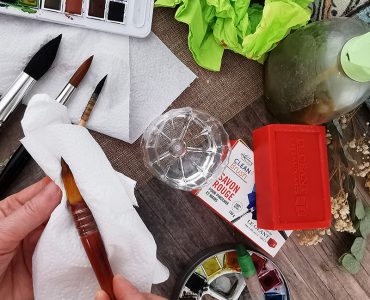What are the differences between Heavy, Soft & Fluid body?
It is not always easy to find what you want among all these brands of acrylic paint. Generally when an artist seeks acrylic paint, he wants a particular colour, but also a perfect viscosity.
Heavy Body, Soft Body, Fluid Body, several types of acrylic paint exist on the market but there is no standard type, so the specifics noted on tubes or pots can make the choice easier.
Acrylic paint : Colour and viscosity
The binder or acrylic resin added to the pigment gives more or less body to the acrylic paint. The paint can be made to be more or less pasty (soft or liquid).
<3 types of Viscosity with Acrylic Paint
1/ Heavy Body:
High viscosity, heavy density, a firm paste with good hold. The viscosity seems like “peanut butter” or oil paint.
Ideal for painting with a knife or colour shaper in thick layers, or impasto, keeps the marks of the tool with relief. We can use the paint directly out of the tube, without being diluted. You can add water or fluid medium if you need to increase flow of colour.
Some Examples: Lukas Pastos, Vallejo, Old Holland, Liquitex Heavy Body Acrylics, Amsterdam Expert Series, Golden Heavy Body Acrylics. Sennelier, Abstract.
How do you know if it’s heavy body?
The paint can make some spikes, maintain the given shape and does not collapse when pulling the paste with a palette knife.
2/ Soft Body:
Creamy paste, soft with flabby viscosity like “custard”.
Perfect for details with a brush, glazing and application of undercoats or very pigmented flat areas. Soft Body can be mixed with a medium to increase viscosity or to be even thinner for nice glaze
Some Examples: Lukascryl Studio, Liquitex Soft Body, Flashe Lefranc & Bourgeois.
How do I know if it’s soft body?
The paint forms beads and spreads slightly when mixed with a palette knife.
3/ Fluid body:
High Flow, Fluid and rich paint extremely diluted with good pigmentation. This paint flows and drops like “milk”. Ideal paint for paintbrush, airbrush, watercolor, textiles and frescoes…
Some Examples: Golden High Flow, Liquitex ink, Daler Rowney FW Acrylic Inks
How do you know if it’s fluid body?
The paint flows in all directions and produces drops when mixed with a palette knife.
Did you know?
Mediums, modeling pastes and gels allow you to change the viscosity of the acrylic paint, so do not forget to make mixtures if you need more thickness or more fluidity.
All these products can be found at GreatArt.co.uk, shopping online and in Store (London Shoreditch).
Information for this article was provided by professional fine artist, Amylee Paris. You can visit her colourful portfolio or follow her on Facebook and Instagram.
Find all Amylee’s posts published in GreatArt online Magazine by clicking here!
GreatArt – your art superstore
Art supplies, ideas and advice for all techniques.
GreatArt offers you art supplies for all techniques from:
- traditional fine art painting,
- drawing,
- sculpture,
- printmaking,
- graphic art,
- illustration,
- airbrushing,
- model making…
We offer an extensive range of stretched canvas and display products for exhibition, all the art supplies required to create your own bespoke canvases, as well as custom framing and mounting services from GreatArt Store. You’ll also find hundreds of articles and tutorials to browse in the online magazine.





















Unless you’re practicing or experimenting, I recommend using only paints with excellent or very good lightfastness ratings. Some artists might use several types in the same painting, but if you’re just starting out, begin with the more common heavy body acrylics because they can still be thinned with water or an acrylic medium if needed.
This says nothing about pigment load, coverage, cost comparison. I think it’s mainly an advert
Hi Salinda,
Amylee’s intention with this post was just to discuss the 3 main viscosity types available and highlight some ranges for each. If you’re looking for details information about a particular acrylic I recommend visiting the individual product pages on our website or contacting customer services for advice.